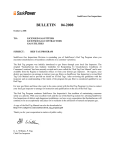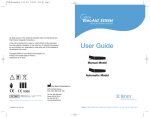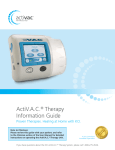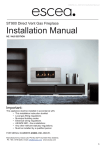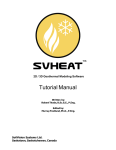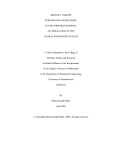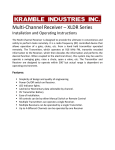Download SASKPOWER RED TAG PROGRAM USER MANUAL
Transcript
SASKPOWER RED TAG PROGRAM USER MANUAL Rev. 2008-11-17 INDEX Preface 2 Scope 2 Definitions 2 Notification 3 Reporting Procedures 3 Returning the Corrected Red Tag Defect_______________________________4 Sample Red Tag (two sided tag) - Filling Out Guide 4-5 Carbon monoxide (CO) standards and guidelines 6 Carbon monoxide (CO) response guidelines 7 Sources 9 Appendix - Gas Inspection Act reference 9 Report phone and fax numbers / Inspectors list 1 10 Preface The Red Tag Program was developed to provide a consistent means for gas utilities, propane distributors, gas contractors or others deemed appropriate by the chief gas inspector to report unresolved gas related deficiencies or identify reoccurring design flaws. The issuing of red tags shall be done by a licensed gasfitter. This allows SaskPower Gas Inspections to ensure that legitimate hazardous or potentially hazardous conditions are resolved in a timely fashion and to address design flaws through the appropriate certification agencies. The main focus is to be on the safety aspect for reporting of deficiencies. Program abuse would result in financial repercussions. Scope The scope of The Red Tag Program applies to all aspects of the gas utilization system including: a) the appliance, equipment, component or accessory where gas is to be used; b) the piping and tubing system c) the venting system d) any material that is composed predominantly of the following or mixtures of them - methane (natural gas), propane (liquid or vapour), butane, hydrogen gas, manufactured gas and fuel oil. Definitions Deficiency - is an imperfection in an appliance, equipment component or accessory that is or has the potential to become unsafe. Design flaw - is a deficiency in an appliance, equipment component or accessory that occurs during the manufacturing process and maybe reoccurring. Gas Inspection Act - is a legislative act mandating SaskPower Gas Inspections to ensure public safety in the use of gas in respect to the following; (a) all gas installations and gas equipment; (b) the inspection of gas installations and gas equipment; (c) the design, manufacture, display, advertising, sale and use of gas equipment; (d) filling plants; (e) portable propane storage containers; (f) the filling of propane automobile storage containers. Hazardous - is a deficiency within a gas system that poses an immediate safety threat to persons or property. Low risk - is a deficiency within a gas system that does not pose as an immediate hazard but has the potential to become unsafe if not rectified. 2 Notification The mandate requiring Gas Inspections to investigate accidents is contained in The Gas Inspection Act, 1993. (See clauses in the appendix pg. 8) Reporting Procedures Low Risk • The preferable action is to immediately correct or arrange to correct, with the owner, the deficiency. In this case a red tag is not necessary unless in the opinion of the gasfitter the deficiency is a result of a design flaw. • If the deficiency is not corrected or arrangements to correct have not been made with the owner do the following: · advise the owner of the deficiency and their responsibility to have it corrected. Note: the district gas inspector determines timelines for correction based on the defect state and will inform owner if necessary. · fill out the red tag and attach the red/buff copy to the gas line at the appliance. · fax or send the white copy by 9:00 AM the following day to SaskPower Gas Inspections to the address or fax number listed in the appendix. Hazardous • If the hazardous condition can not be immediately corrected do the following; · turn the gas supply off to the appliance causing the hazard or the gas service to the building to neutralize the hazardous condition. · advise the owner of the deficiency and the corrections required. · advise the owner corrections must be verified by a licensed gasfitter and/or a gas inspector before the fuel supply can be turned on. · fill out the red tag and attach the red/buff copy to the gas line at the appliance. · fax or send the white copy by 9:00 AM the following day to SaskPower Gas Inspections to the address or fax number listed in the appendix. Property damage or injury • If the Red Tag condition involves an injury, hospitalization or death to any person and/or a fire or an explosion and the gas appliances or equipment may be the cause, it must be reported immediately. Do not disturb any gas appliances or equipment until written permission of a gas inspector has been obtained. • Immediate Report To reach any gas inspection offices phone 1-888-757-6937 3 Returning the Corrected Red Tag Defect When the red tag defect has been corrected it is the responsibility of the correcting gas fitter to detach the red tag from the gas line, fill out the information on the back side (red side) and fax or send the red tag to the Saskatoon or Regina office. This will help ensure the red tag defects are dealt with in a timely fashion. Sample Red Tag (two sided tag) - Filling Out Guide Condition Report Side Please make sure all information is legible (print) and accurate for efficient follow up. Attach Red Tag to gas line at the defect location. 1. Defect location - There are three types of location choices a) urban - town or city and the civic address b) rural - RM number and land description (includes quarter, section, township, range and meridian) c) Indian reserve - reserve number and house number 2. Owner and occupant - owner and occupant name, phone number and indicate if notified - if owner is the occupant indicate “same” in occupant box 3. Gas contractor/Company - company name and phone number 4. Reporter/gasfitter - name of attending gas fitter 5. CO reading ppm - if CO test is preformed enter result here in ppm 6. Defect - briefly describe the defect providing enough information to make sense 7. Date - the date the defect was found and reported to inspections 8. Faxed - indicate where condition report was sent 9. Red tag number - your reference number 10. Condition - Hazardous - unsafe to operate, the fuel supply is off - Low Risk - safe to operate, the fuel supply has been left on 4 Correction Report Side To be filled out and returned by the correcting gas fitter. 1. Corrections - briefly describe the correction providing enough information to make sense 2. Gas Contractor - company name and phone number 3. Gas Fitter - name of attending gas fitter and their license number 4. Reporting Info - indicate where the correction report was sent 5. Permit # - if the correction required a permit indicate the permit number 7. Date - the date the correction was made 5 CARBON MONOXIDE (CO) STANDARDS AND GUIDELINES SaskPower Gas Inspection Division offers these common action levels along with nationally recognized standards of concentration for informational purposes, as they appear to be reasonable and common standards of practice. HEALTH CANADA - EXPOSURE GUIDELINES FOR RESIDENTIAL INDOOR AIR QUALITY • Carbon Monoxide concentrations 0 - 2 ppm normal conditions in and out side Canadian homes 11 ppm maximum tolerable indoor concentration over an eight-hour period AMERICAN SOCIETY OF HEATING, REFRIGERATION & AIR CONDITIONING ENGINEERS (ASHRAE) - STANDARD 62-2007 VENTILATION FOR ACCEPTABLE INDOOR AIR QUALITY • Canadian exposure guideline for residential indoor air quality: 11 ppm eight-hour average concentration; 25 ppm one-hour average concentration. SASKATCHEWAN LABOUR – OCCUPATIONAL HEALTH AND SAFETY ACT, 1993 • Carbon monoxide contamination limits for the workplace: 25 ppm eight-hour average contamination limit. 190 ppm 15 min average contamination limit 6 CARBON MONOXIDE (CO) RESPONSE GUIDELINE SaskPower Gas Inspection Division offers these standard action levels for informational purposes. Any increase in parts per million (ppm) from outside to inside warrants further investigation as to the source and should be documented. Standard for Action Levels The following action levels have been defined as minimums for an operator trained by the manufacturer of the testing equipment. An operator may adopt more stringent standards than the ones defined in this document. As such, the operator may enforce those higher standards. Under no circumstances shall an operator trained by the manufacturer of the testing equipment recognize less stringent standards or ignore conditions in excess of the defined action levels. The action levels are considered net indoor ambient readings - i.e. - indoor ambient minus outdoor ambient readings. 0 to 9 parts per million (ppm) net indoor Normal: CO levels in this range are acceptable for short periods (8 hr. average concentration). Action: No Action. Typical from outdoor sources, fumes from attached garages, heavy smoking, burning candles, wood burning fireplace spillage and operation of unvented cooking appliances. If unvented cooking appliances are in operation, recommend additional ventilation in areas of operation. With concentrations in this range, the operator may continue testing sequences. 10 to 35 parts per million (ppm) net indoor MANDATORY REPORT Concern: This level could become hazardous in some situations. Actions: Occupants should be advised of a potential health hazard to small children, elderly people and persons suffering from respiratory or heart problems. If the home has an attached garage document CO levels in the garage. With concentrations in this range, the operator must continue testing to locate the CO source. Test combustion appliances one at a time to determine the source of CO production. If an appliance is determined to be the source of CO production, it should be shut off and not used until a licensed gas fitter can service it. 36 to 99 parts per million (ppm) net indoor MANDATORY REPORT Excessive: Medical Alert. This is a hazardous condition. Actions: Ask occupants to step outside and query about health symptoms. Advise occupants to seek medical attention. Advise occupants not to drive. Emergency service personnel must be called if occupants exhibit symptoms of CO poisoning. Enter the building, open doors and windows to ventilate the structure. Turn off all combustion appliances until the CO level has been reduced to below 10 ppm. If the home has an attached garage document CO levels in garage. Test combustion appliances one at a time to determine the source of CO production. If an appliance is determined to be the source of CO production, it should be shut off and not used until a licensed gas fitter can service it. 7 100 - 200 parts per million (ppm) net indoor MANDATORY REPORT Dangerous: Medical Alert. Emergency conditions exist. Actions: Evacuate the building immediately and check occupants for health symptoms. Advise all occupants to seek medical attention. Advise occupants not to drive. Emergency service personnel must be called if occupants exhibit symptoms of CO poisoning Evacuation is important, but operators must not subject themselves to excessive conditions. Maximum exposure time is 15 minutes. Open all doors and windows that can be done quickly. If the home has an attached garage document CO levels in garage. Disable combustion appliance operation. This may involve shutting of the service valve. Continually monitor indoor ambient levels while moving through the building. Once the atmosphere within the structure has returned to below 10 ppm test combustion appliances one at a time to determine the source of CO production. If an appliance is determined to be the source of CO production, it should be shut off and not used until a licensed gas fitter can service it. Greater than 200 parts per million (ppm) net indoor MANDATORY REPORT Dangerous: Medical Alert. Emergency conditions exist. Extremely hazardous. Actions: Evacuate the building immediately and check occupants for health symptoms. Advise all occupants to seek medical attention. Advise occupants not to drive. Emergency service personnel must be called if occupants exhibit symptoms of CO poisoning. Evacuation is important, but operators must not subject themselves to these conditions. Disable combustion appliance operation. This may involve shutting of the service valve. Do not stay inside or re-enter the building until conditions have dropped below 100 ppm. Open all doors and windows that can be done quickly without entering the structure. Shut off gas supply (if applicable and necessary). If the home has an attached garage, document CO levels in garage if possible to do so without being subjected to high levels of CO. Once the atmosphere within the structure has returned to below 10 ppm test combustion appliances one at a time to determine the source of CO production. If an appliance is determined to be the source of CO production, it should be shut off and not used until a licensed gas fitter can service it. Where a gas appliance is the possible source of the CO or the source can not be determined and the net indoor reading is in excess of 9 ppm, a report must be sent to SaskPower Gas Inspection Division. 8 SOURCES Health Canada • Exposure Guideline for Residential Indoor Air Quality American Society of Heating, Refrigeration & Air Conditioning Engineers (ASHRAE) • Standard 62-1999 Ventilation for Acceptable Indoor Air Quality Saskatchewan Labour • Occupational Health and Safety Act, 1993 Appendix Gas Inspection Act References Reporting of accidents 29 Where an accident involving a gas installation or gas equipment occurs and results in the death or injury of a person or in a fire or an explosion, the contractor or the contractor’s agent or the owner of the gas equipment or the owner’s agent shall immediately notify the chief inspector, stating the precise location of the accident, its general nature and results. Investigation of accidents 30 Subject to The Coroners Act, 1999, The Fire Prevention Act, 1992 and The Occupational Health and Safety Act, 1993: (a) where an accident described in section 29 occurs, no part of any gas facility, gas installation or gas equipment involved is to be removed or its position altered by any person, except for the purposes of rescuing persons injured or removing the bodies of persons killed, until the written permission of an inspector has been obtained; and (b) an inspector may: (i) investigate a death or injury of a person, a fire or an explosion that the inspector has reason to believe has been caused by any gas equipment or gas installation to which this Act applies; and (ii) remove from the premises all or any part of the gas equipment to provide evidence regarding the cause of the death, injury, fire or explosion or to further investigate the gas equipment. 9 10















